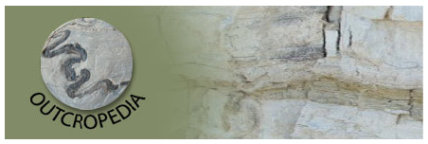Vertical E-W trending foliation surface of Yarweelor bi-granite gneiss (reworked Yilgarn gneiss – protolith 3.7-2.4 Ga) showing two lineations: one stretching lineation (vague striping) plunging gently (14°) to the east (left) and one biotite mineral lineation plunging steeply ( 60°) to the east (left). The latter lineation is parallel to elliptical aggregates of biotite which may represent pseudomorphs after another mineral (garnet?). In that case, this unknown mineral must have predated the steep lineation, which would therefore be the younger one of the two. The gently lineation is interpreted as D1: the steep one as D2. The D1-lineation is best visible at the top and bottom of the photograph. Vertical outcrop surface. The two lineations are thought to represent the two phases of activity of the Erabiddy shear zone.
Vertical E-W trending foliation surface of Yarweelor bi-granite gneiss (reworked Yilgarn gneiss – protolith 3.7-2.4 Ga) showing two lineations: one stretching lineation (vague striping) plunging gently (14°) to the east (left) and one biotite mineral lineation plunging steeply ( 60°) to the east (left). The latter lineation is parallel to elliptical aggregates of biotite which may represent pseudomorphs after another mineral (garnet?). In that case, this unknown mineral must have predated the steep lineation, which would therefore be the younger one of the two. The gently lineation is interpreted as D1: the steep one as D2. The D1-lineation is best visible at the top and bottom of the photograph. Vertical outcrop surface. The two lineations are thought to represent the two phases of activity of the Erabiddy shear zone.
Photograph: Cees Passchier
